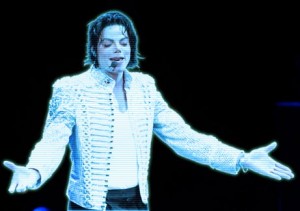Creative or Creepy? The Michael Jackson Hologram and Humanism

Last week in Las Vegas at the Billboard Music Awards, Michael Jackson brought the live audience to its feet as he moonwalked across the stage. The problem? He’s been dead for four years. The image of Jackson dancing and singing at the awards was the result of innovative digital technology.
While the Billboard audience seemed thrilled with the King of Pop’s simulacra, fans around the world spoke out on social media to voice their disapproval, calling the projection “creepy,” “confusing and uncomfortable,” and likening Jackson’s image to “a zombie.” Others were delighted that Jackson had been resurrected from the grave. But beyond initial reactions of revulsion or excitement, some were asking questions about the ethical nature of reanimating a dead celebrity to perform in front of a live audience.
Humanism, as a philosophy concerned with the ethics of human life and our shared humanity, can inform our understanding of just what happened on that stage in Las Vegas. Initially, humanists and fans might be quite pleased with the performance. Jackson’s “hologram,” though novel, is not the first. For instance, in 2007 a “rotoscoped” image of Elvis Presley sang a duet with Celine Dion on American Idol, and in 2012 a digital recreation of Tupac Shakur rapped at the popular Coachella music festival in Indio, California. But this latest example is perhaps the most life-like audiences have seen yet.
It’s also exciting to think that celebrities may be able to “live on” after they have died. As humanists, we realize that this existence is all we have, but seeing a moving likeness of Jackson on a live stage gives fans a more vivid way to remember him. The performance, much like his recently released album of contemporized songs, could be interpreted as an homage to his legacy that also introduces him to a new generation. Esco “Jackie” Jackson, for instance, was enthusiastic about the tribute to his brother, hailing it as “incredible, amazing.”
While these are certainly valid reactions to the Billboard show, some might want to look beyond the initial performance and ask what it means when the music industry can revive a dead man to sing and dance on stage for profit. Some critics of the Billboard performance claimed that Epic Records’ use of the hologram was nothing more than crass consumerism and an exploitation of Jackson’s memory. Of course, there’s nothing new about studios using a departed singer to make a buck. Posthumous albums have been released by Nat King Cole, Frank Sinatra, and Amy Winehouse, to name a few. In many ways, presenting dead celebrities visually in front of an audience is not so different from distributing an album of unreleased tracks or re-mastered standards. Cynics might even go so far as to say that Jackson, like all too many before him, had been exploited by the music industry since his childhood, so there’s nothing surprising about his label continuing to cash in on his image. What Epic Records has done to Jackson in death is, arguably, not that different from what they were doing to him while he was alive.
Is there a difference between commodifying a celebrity in death, as opposed to in life? At least during their lifetimes, celebrities can participate in their branding and presentation. Michael Jackson in particular was known as a perfectionist when it came to his music and choreography, and no one knows how he might have felt about last Sunday’s spectacle. Epic Records CEO L. A. Reid said as much, as reported by The Huffington Post. Jermaine Jackson has been vocal about his disapproval of his brother’s second posthumous album, claiming that Jackson would have been disappointed with the songs’ lack of quality, and he expressed disappointment at the studio’s departure from Jackson’s vision just to turn a profit.
Something is lost when our society reduces a human being to a mere commodity to be bought and sold. Consumerism reduces a person’s worth to mere dollars and cents and flattens a human being into a mere object to be used and disregarded based on the whims of buyers. Humanism, however, affirms the intrinsic worth of one’s value as a human being. Each person is the awe-inspiring result of billions of years of evolution and a unique genetic makeup and cultural background, all of which contributes to an individual’s personality and talents. In the first view, Jackson’s memory is a product to be packaged only as long as someone is willing to pay for it. In the second view, Jackson was a man who, though flawed, used his talent to leave a musical legacy that forever changed popular music and brought joy to people around the world.
Was the Michael Jackson hologram a memorial of a gifted performer brought to us by the wonders of technology? Was it a dehumanizing attempt at a publicity stunt to boost album sales? Or was it a little bit of both?
